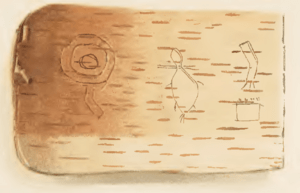Wiigwaasabak facts for kids
Wiigwaasabak (pronounced "wee-gwaas-ah-bahk") are special scrolls made from birch bark. The Ojibwe people, also known as the Anishinaabe, used them. They wrote complex patterns and shapes on these scrolls. These patterns were like a written language.
When used for special ceremonies called Midewiwin, these scrolls are called mide-wiigwaas. The scrolls helped people remember important ideas. They also helped pass down history and stories to new generations. You can see some of these scrolls in museums today. One is at the Smithsonian Museum in Washington, DC. Besides birch bark, other materials like copper, slate, hides, and pottery were also used. Experts are still trying to find out exactly when and where these scrolls were used. Many scrolls were hidden in caves or special underground spots to keep them safe.
How Wiigwaasabak Were Made
The bark from the paper birch tree was a great material for writing. People used a tool called a stylus. This stylus was often made from bone, metal, or wood. They used it to draw symbols on the soft inner bark. Black charcoal was often rubbed into the lines. This made the drawings easier to see.
To make a scroll, pieces of bark were sewn together. They used watap, which are roots from cedar or spruce trees. To keep the scroll from unrolling, it was tied up. Then, it was placed inside a wiigwaasi-makak. This is a cylindrical box also made from birch bark. Elders would copy the scrolls every so often. They stored them in dry places, sometimes underground or in caves. Scrolls were often kept secret. This was to make sure they were understood correctly. It also protected the teachings from being disrespected.
Why These Scrolls Were Important
Some wiigwaasabak scrolls contain songs. They also detail the rituals of the Midewiwin ceremonies and healing practices. Some of the oldest maps of North America were made by Native peoples. They drew these maps on birch bark for explorers and traders to follow.
Other scrolls tell the story of the Ojibwe migration. This was their journey from eastern North America to the west. These scrolls mention finding miigis shells. These are white cowrie shells. They were found as the Ojibwe traveled through the Great Lakes region. These shells are used in Midewiwin ceremonies. Whiteshell Provincial Park is even named after these shells. Since these shells grow in oceans, not fresh water, it shows that the Ojibwe had a large trading network.
The Ojibwe people used birch bark to keep records. These records helped them learn and guide their lives. Songs and healing recipes could be read by tribe members. Scrolls could have many pictures. These pictures were made by engraving or using red and blue colors. Birch bark scrolls could be different sizes. Some were just a few centimeters, while others were several meters long.
The traditions and scrolls are still alive today. They are passed down from older generations to younger ones. The Midewiwin group continues to keep the scrolls and their teachings alive. Some parts are kept secret. This helps keep the scrolls safe and ensures they are interpreted correctly. It also helps wait until there is more respect for this ancient writing system. Scrolls are shared along with the oral stories that go with them. Complex stories are shown and remembered using the pictures on the scrolls.
Some elders and Indigenous teachers believe humans lived in North America before the last ice age. Ancient writing methods and other old artifacts might give clues. These clues could help us understand how people moved and lived in North and South America long ago.
What Archaeology Tells Us
Archaeology in the 20th century has shown that Native Americans have used birch bark scrolls for over 400 years. In 1965, an archaeologist named Kenneth Kidd found two pieces of birch bark. They had drawings of animals, birds, people, legendary creatures, and special symbols. These finds were in the Head-of-the-Lakes region of Ontario. Some of these drawings looked like scrolls used by the Mide Society of the Ojibwe.
Kidd concluded that Indigenous people sometimes hid these artifacts. They would bury them or put them in caves. It is not clear exactly when this was done. But archaeologists should know about this custom. They should look for these hidden scrolls. Another scroll from a different collection was later dated. It was found to be from about 1560, give or take 70 years.


